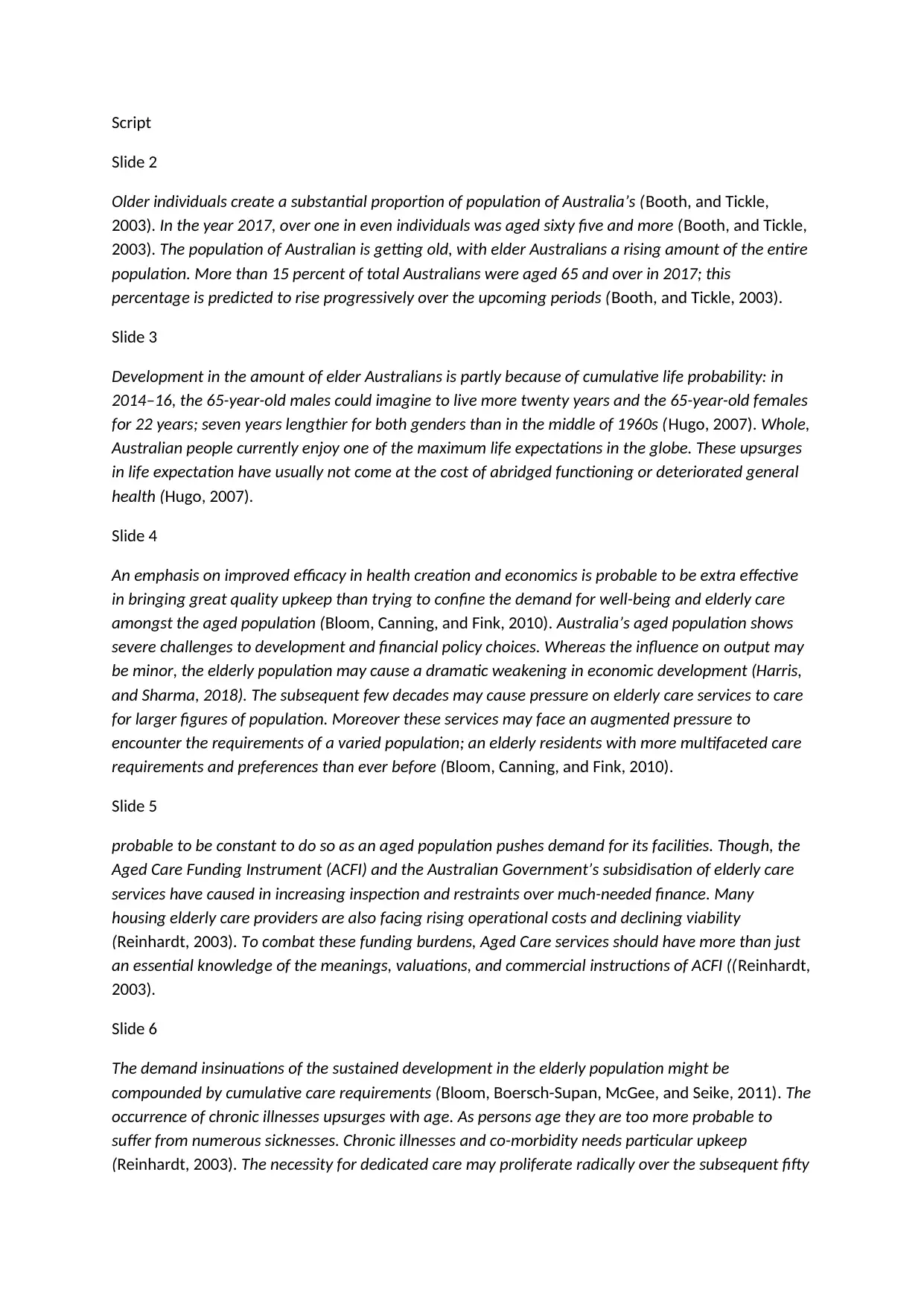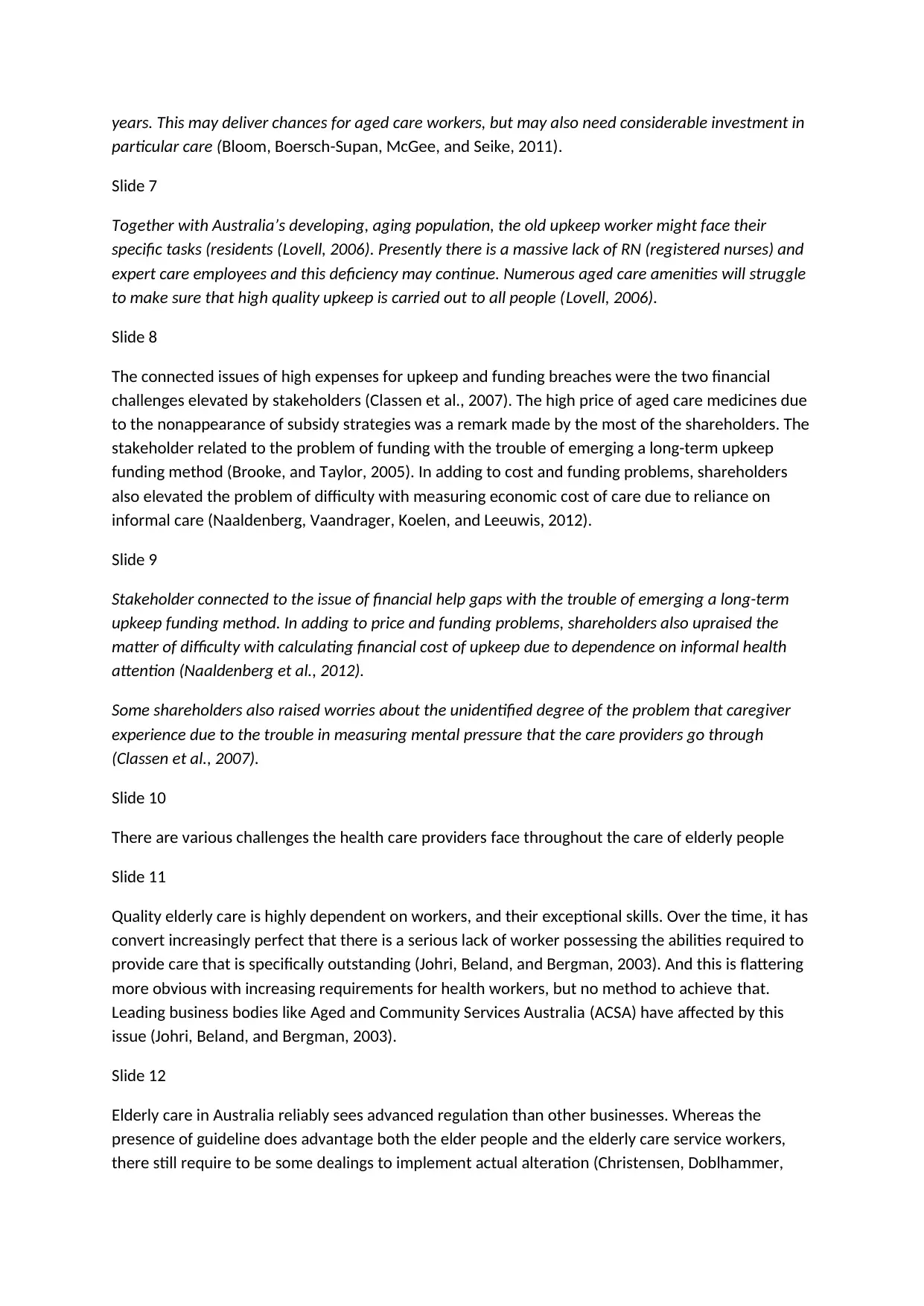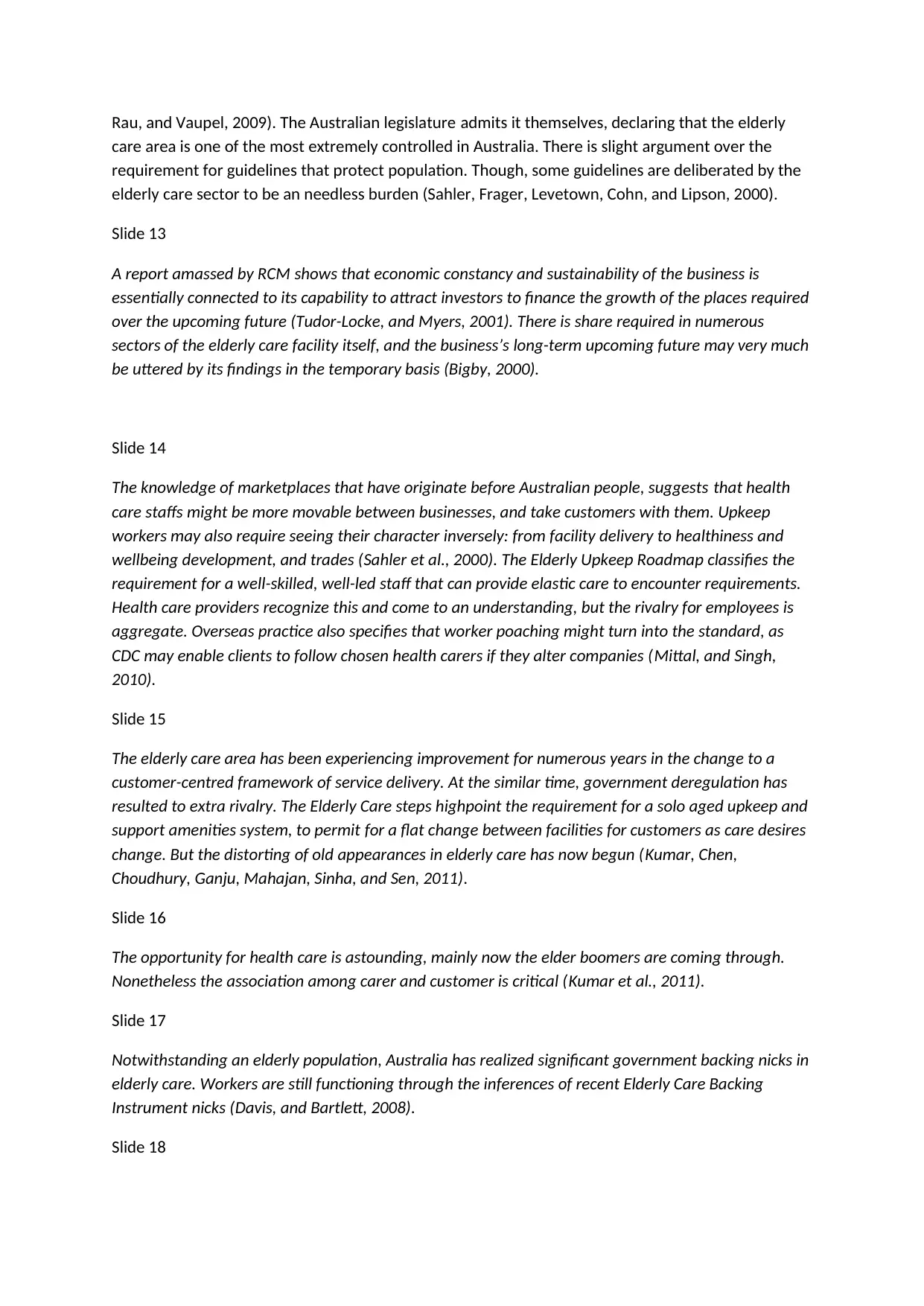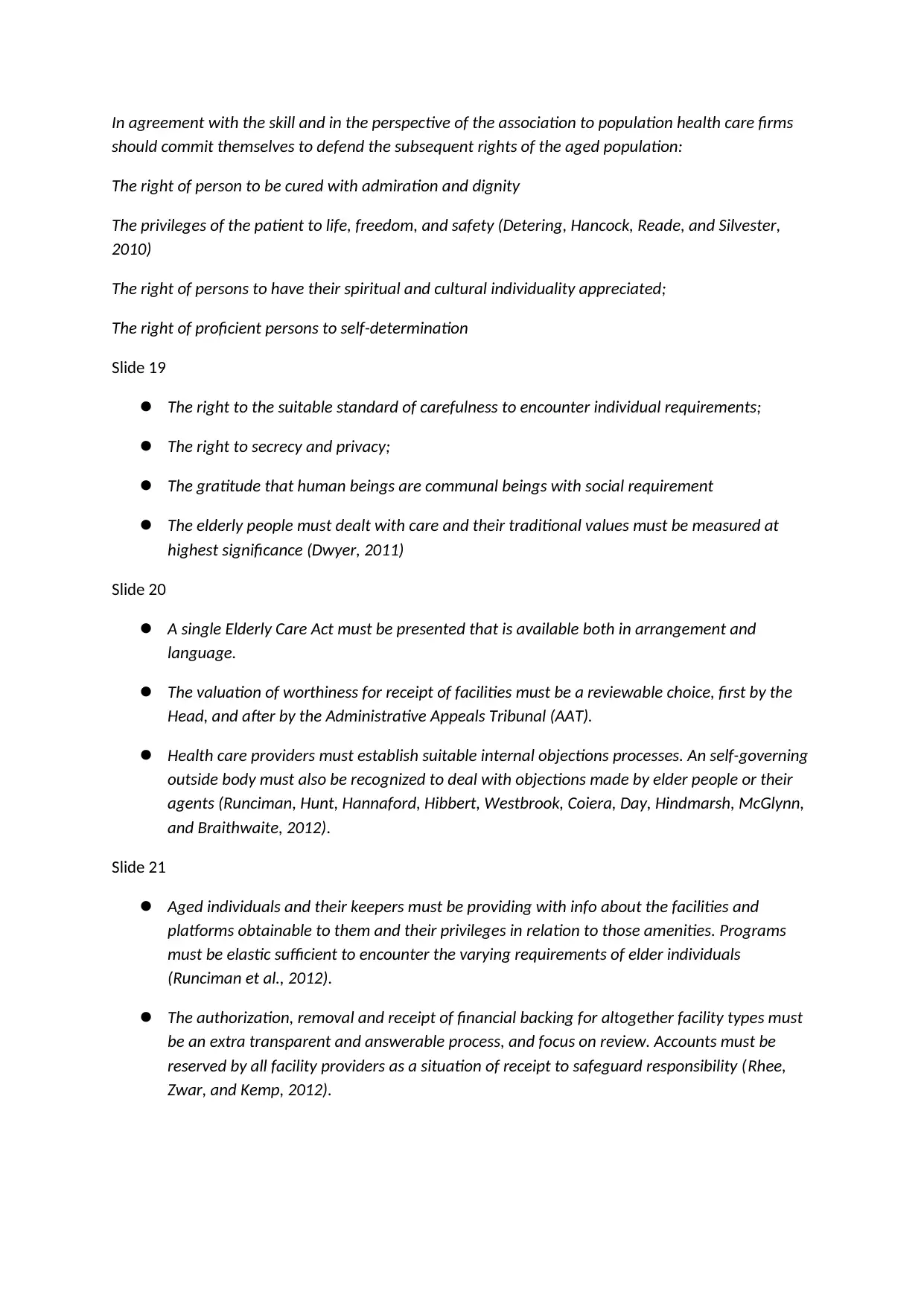Challenges and Implications of Australia's Aging Population
VerifiedAdded on 2023/04/20
|4
|1866
|83
AI Summary
This document discusses the challenges and implications of Australia's aging population, including the increasing demand for elderly care services and the need for funding and regulation. It highlights the impact of an aging population on healthcare and the importance of quality care for the elderly. The document also explores the challenges faced by healthcare providers in meeting the care needs of elderly individuals and the importance of skilled workers in the elderly care sector.
Contribute Materials
Your contribution can guide someone’s learning journey. Share your
documents today.

Script
Slide 2
Older individuals create a substantial proportion of population of Australia’s (Booth, and Tickle,
2003). In the year 2017, over one in even individuals was aged sixty five and more (Booth, and Tickle,
2003). The population of Australian is getting old, with elder Australians a rising amount of the entire
population. More than 15 percent of total Australians were aged 65 and over in 2017; this
percentage is predicted to rise progressively over the upcoming periods (Booth, and Tickle, 2003).
Slide 3
Development in the amount of elder Australians is partly because of cumulative life probability: in
2014–16, the 65-year-old males could imagine to live more twenty years and the 65-year-old females
for 22 years; seven years lengthier for both genders than in the middle of 1960s (Hugo, 2007). Whole,
Australian people currently enjoy one of the maximum life expectations in the globe. These upsurges
in life expectation have usually not come at the cost of abridged functioning or deteriorated general
health (Hugo, 2007).
Slide 4
An emphasis on improved efficacy in health creation and economics is probable to be extra effective
in bringing great quality upkeep than trying to confine the demand for well-being and elderly care
amongst the aged population (Bloom, Canning, and Fink, 2010). Australia’s aged population shows
severe challenges to development and financial policy choices. Whereas the influence on output may
be minor, the elderly population may cause a dramatic weakening in economic development (Harris,
and Sharma, 2018). The subsequent few decades may cause pressure on elderly care services to care
for larger figures of population. Moreover these services may face an augmented pressure to
encounter the requirements of a varied population; an elderly residents with more multifaceted care
requirements and preferences than ever before (Bloom, Canning, and Fink, 2010).
Slide 5
probable to be constant to do so as an aged population pushes demand for its facilities. Though, the
Aged Care Funding Instrument (ACFI) and the Australian Government’s subsidisation of elderly care
services have caused in increasing inspection and restraints over much-needed finance. Many
housing elderly care providers are also facing rising operational costs and declining viability
(Reinhardt, 2003). To combat these funding burdens, Aged Care services should have more than just
an essential knowledge of the meanings, valuations, and commercial instructions of ACFI ((Reinhardt,
2003).
Slide 6
The demand insinuations of the sustained development in the elderly population might be
compounded by cumulative care requirements (Bloom, Boersch-Supan, McGee, and Seike, 2011). The
occurrence of chronic illnesses upsurges with age. As persons age they are too more probable to
suffer from numerous sicknesses. Chronic illnesses and co-morbidity needs particular upkeep
(Reinhardt, 2003). The necessity for dedicated care may proliferate radically over the subsequent fifty
Slide 2
Older individuals create a substantial proportion of population of Australia’s (Booth, and Tickle,
2003). In the year 2017, over one in even individuals was aged sixty five and more (Booth, and Tickle,
2003). The population of Australian is getting old, with elder Australians a rising amount of the entire
population. More than 15 percent of total Australians were aged 65 and over in 2017; this
percentage is predicted to rise progressively over the upcoming periods (Booth, and Tickle, 2003).
Slide 3
Development in the amount of elder Australians is partly because of cumulative life probability: in
2014–16, the 65-year-old males could imagine to live more twenty years and the 65-year-old females
for 22 years; seven years lengthier for both genders than in the middle of 1960s (Hugo, 2007). Whole,
Australian people currently enjoy one of the maximum life expectations in the globe. These upsurges
in life expectation have usually not come at the cost of abridged functioning or deteriorated general
health (Hugo, 2007).
Slide 4
An emphasis on improved efficacy in health creation and economics is probable to be extra effective
in bringing great quality upkeep than trying to confine the demand for well-being and elderly care
amongst the aged population (Bloom, Canning, and Fink, 2010). Australia’s aged population shows
severe challenges to development and financial policy choices. Whereas the influence on output may
be minor, the elderly population may cause a dramatic weakening in economic development (Harris,
and Sharma, 2018). The subsequent few decades may cause pressure on elderly care services to care
for larger figures of population. Moreover these services may face an augmented pressure to
encounter the requirements of a varied population; an elderly residents with more multifaceted care
requirements and preferences than ever before (Bloom, Canning, and Fink, 2010).
Slide 5
probable to be constant to do so as an aged population pushes demand for its facilities. Though, the
Aged Care Funding Instrument (ACFI) and the Australian Government’s subsidisation of elderly care
services have caused in increasing inspection and restraints over much-needed finance. Many
housing elderly care providers are also facing rising operational costs and declining viability
(Reinhardt, 2003). To combat these funding burdens, Aged Care services should have more than just
an essential knowledge of the meanings, valuations, and commercial instructions of ACFI ((Reinhardt,
2003).
Slide 6
The demand insinuations of the sustained development in the elderly population might be
compounded by cumulative care requirements (Bloom, Boersch-Supan, McGee, and Seike, 2011). The
occurrence of chronic illnesses upsurges with age. As persons age they are too more probable to
suffer from numerous sicknesses. Chronic illnesses and co-morbidity needs particular upkeep
(Reinhardt, 2003). The necessity for dedicated care may proliferate radically over the subsequent fifty
Secure Best Marks with AI Grader
Need help grading? Try our AI Grader for instant feedback on your assignments.

years. This may deliver chances for aged care workers, but may also need considerable investment in
particular care (Bloom, Boersch-Supan, McGee, and Seike, 2011).
Slide 7
Together with Australia’s developing, aging population, the old upkeep worker might face their
specific tasks (residents (Lovell, 2006). Presently there is a massive lack of RN (registered nurses) and
expert care employees and this deficiency may continue. Numerous aged care amenities will struggle
to make sure that high quality upkeep is carried out to all people (Lovell, 2006).
Slide 8
The connected issues of high expenses for upkeep and funding breaches were the two financial
challenges elevated by stakeholders (Classen et al., 2007). The high price of aged care medicines due
to the nonappearance of subsidy strategies was a remark made by the most of the shareholders. The
stakeholder related to the problem of funding with the trouble of emerging a long-term upkeep
funding method (Brooke, and Taylor, 2005). In adding to cost and funding problems, shareholders
also elevated the problem of difficulty with measuring economic cost of care due to reliance on
informal care (Naaldenberg, Vaandrager, Koelen, and Leeuwis, 2012).
Slide 9
Stakeholder connected to the issue of financial help gaps with the trouble of emerging a long-term
upkeep funding method. In adding to price and funding problems, shareholders also upraised the
matter of difficulty with calculating financial cost of upkeep due to dependence on informal health
attention (Naaldenberg et al., 2012).
Some shareholders also raised worries about the unidentified degree of the problem that caregiver
experience due to the trouble in measuring mental pressure that the care providers go through
(Classen et al., 2007).
Slide 10
There are various challenges the health care providers face throughout the care of elderly people
Slide 11
Quality elderly care is highly dependent on workers, and their exceptional skills. Over the time, it has
convert increasingly perfect that there is a serious lack of worker possessing the abilities required to
provide care that is specifically outstanding (Johri, Beland, and Bergman, 2003). And this is flattering
more obvious with increasing requirements for health workers, but no method to achieve that.
Leading business bodies like Aged and Community Services Australia (ACSA) have affected by this
issue (Johri, Beland, and Bergman, 2003).
Slide 12
Elderly care in Australia reliably sees advanced regulation than other businesses. Whereas the
presence of guideline does advantage both the elder people and the elderly care service workers,
there still require to be some dealings to implement actual alteration (Christensen, Doblhammer,
particular care (Bloom, Boersch-Supan, McGee, and Seike, 2011).
Slide 7
Together with Australia’s developing, aging population, the old upkeep worker might face their
specific tasks (residents (Lovell, 2006). Presently there is a massive lack of RN (registered nurses) and
expert care employees and this deficiency may continue. Numerous aged care amenities will struggle
to make sure that high quality upkeep is carried out to all people (Lovell, 2006).
Slide 8
The connected issues of high expenses for upkeep and funding breaches were the two financial
challenges elevated by stakeholders (Classen et al., 2007). The high price of aged care medicines due
to the nonappearance of subsidy strategies was a remark made by the most of the shareholders. The
stakeholder related to the problem of funding with the trouble of emerging a long-term upkeep
funding method (Brooke, and Taylor, 2005). In adding to cost and funding problems, shareholders
also elevated the problem of difficulty with measuring economic cost of care due to reliance on
informal care (Naaldenberg, Vaandrager, Koelen, and Leeuwis, 2012).
Slide 9
Stakeholder connected to the issue of financial help gaps with the trouble of emerging a long-term
upkeep funding method. In adding to price and funding problems, shareholders also upraised the
matter of difficulty with calculating financial cost of upkeep due to dependence on informal health
attention (Naaldenberg et al., 2012).
Some shareholders also raised worries about the unidentified degree of the problem that caregiver
experience due to the trouble in measuring mental pressure that the care providers go through
(Classen et al., 2007).
Slide 10
There are various challenges the health care providers face throughout the care of elderly people
Slide 11
Quality elderly care is highly dependent on workers, and their exceptional skills. Over the time, it has
convert increasingly perfect that there is a serious lack of worker possessing the abilities required to
provide care that is specifically outstanding (Johri, Beland, and Bergman, 2003). And this is flattering
more obvious with increasing requirements for health workers, but no method to achieve that.
Leading business bodies like Aged and Community Services Australia (ACSA) have affected by this
issue (Johri, Beland, and Bergman, 2003).
Slide 12
Elderly care in Australia reliably sees advanced regulation than other businesses. Whereas the
presence of guideline does advantage both the elder people and the elderly care service workers,
there still require to be some dealings to implement actual alteration (Christensen, Doblhammer,

Rau, and Vaupel, 2009). The Australian legislature admits it themselves, declaring that the elderly
care area is one of the most extremely controlled in Australia. There is slight argument over the
requirement for guidelines that protect population. Though, some guidelines are deliberated by the
elderly care sector to be an needless burden (Sahler, Frager, Levetown, Cohn, and Lipson, 2000).
Slide 13
A report amassed by RCM shows that economic constancy and sustainability of the business is
essentially connected to its capability to attract investors to finance the growth of the places required
over the upcoming future (Tudor-Locke, and Myers, 2001). There is share required in numerous
sectors of the elderly care facility itself, and the business’s long-term upcoming future may very much
be uttered by its findings in the temporary basis (Bigby, 2000).
Slide 14
The knowledge of marketplaces that have originate before Australian people, suggests that health
care staffs might be more movable between businesses, and take customers with them. Upkeep
workers may also require seeing their character inversely: from facility delivery to healthiness and
wellbeing development, and trades (Sahler et al., 2000). The Elderly Upkeep Roadmap classifies the
requirement for a well-skilled, well-led staff that can provide elastic care to encounter requirements.
Health care providers recognize this and come to an understanding, but the rivalry for employees is
aggregate. Overseas practice also specifies that worker poaching might turn into the standard, as
CDC may enable clients to follow chosen health carers if they alter companies (Mittal, and Singh,
2010).
Slide 15
The elderly care area has been experiencing improvement for numerous years in the change to a
customer-centred framework of service delivery. At the similar time, government deregulation has
resulted to extra rivalry. The Elderly Care steps highpoint the requirement for a solo aged upkeep and
support amenities system, to permit for a flat change between facilities for customers as care desires
change. But the distorting of old appearances in elderly care has now begun (Kumar, Chen,
Choudhury, Ganju, Mahajan, Sinha, and Sen, 2011).
Slide 16
The opportunity for health care is astounding, mainly now the elder boomers are coming through.
Nonetheless the association among carer and customer is critical (Kumar et al., 2011).
Slide 17
Notwithstanding an elderly population, Australia has realized significant government backing nicks in
elderly care. Workers are still functioning through the inferences of recent Elderly Care Backing
Instrument nicks (Davis, and Bartlett, 2008).
Slide 18
care area is one of the most extremely controlled in Australia. There is slight argument over the
requirement for guidelines that protect population. Though, some guidelines are deliberated by the
elderly care sector to be an needless burden (Sahler, Frager, Levetown, Cohn, and Lipson, 2000).
Slide 13
A report amassed by RCM shows that economic constancy and sustainability of the business is
essentially connected to its capability to attract investors to finance the growth of the places required
over the upcoming future (Tudor-Locke, and Myers, 2001). There is share required in numerous
sectors of the elderly care facility itself, and the business’s long-term upcoming future may very much
be uttered by its findings in the temporary basis (Bigby, 2000).
Slide 14
The knowledge of marketplaces that have originate before Australian people, suggests that health
care staffs might be more movable between businesses, and take customers with them. Upkeep
workers may also require seeing their character inversely: from facility delivery to healthiness and
wellbeing development, and trades (Sahler et al., 2000). The Elderly Upkeep Roadmap classifies the
requirement for a well-skilled, well-led staff that can provide elastic care to encounter requirements.
Health care providers recognize this and come to an understanding, but the rivalry for employees is
aggregate. Overseas practice also specifies that worker poaching might turn into the standard, as
CDC may enable clients to follow chosen health carers if they alter companies (Mittal, and Singh,
2010).
Slide 15
The elderly care area has been experiencing improvement for numerous years in the change to a
customer-centred framework of service delivery. At the similar time, government deregulation has
resulted to extra rivalry. The Elderly Care steps highpoint the requirement for a solo aged upkeep and
support amenities system, to permit for a flat change between facilities for customers as care desires
change. But the distorting of old appearances in elderly care has now begun (Kumar, Chen,
Choudhury, Ganju, Mahajan, Sinha, and Sen, 2011).
Slide 16
The opportunity for health care is astounding, mainly now the elder boomers are coming through.
Nonetheless the association among carer and customer is critical (Kumar et al., 2011).
Slide 17
Notwithstanding an elderly population, Australia has realized significant government backing nicks in
elderly care. Workers are still functioning through the inferences of recent Elderly Care Backing
Instrument nicks (Davis, and Bartlett, 2008).
Slide 18

In agreement with the skill and in the perspective of the association to population health care firms
should commit themselves to defend the subsequent rights of the aged population:
The right of person to be cured with admiration and dignity
The privileges of the patient to life, freedom, and safety (Detering, Hancock, Reade, and Silvester,
2010)
The right of persons to have their spiritual and cultural individuality appreciated;
The right of proficient persons to self-determination
Slide 19
The right to the suitable standard of carefulness to encounter individual requirements;
The right to secrecy and privacy;
The gratitude that human beings are communal beings with social requirement
The elderly people must dealt with care and their traditional values must be measured at
highest significance (Dwyer, 2011)
Slide 20
A single Elderly Care Act must be presented that is available both in arrangement and
language.
The valuation of worthiness for receipt of facilities must be a reviewable choice, first by the
Head, and after by the Administrative Appeals Tribunal (AAT).
Health care providers must establish suitable internal objections processes. An self-governing
outside body must also be recognized to deal with objections made by elder people or their
agents (Runciman, Hunt, Hannaford, Hibbert, Westbrook, Coiera, Day, Hindmarsh, McGlynn,
and Braithwaite, 2012).
Slide 21
Aged individuals and their keepers must be providing with info about the facilities and
platforms obtainable to them and their privileges in relation to those amenities. Programs
must be elastic sufficient to encounter the varying requirements of elder individuals
(Runciman et al., 2012).
The authorization, removal and receipt of financial backing for altogether facility types must
be an extra transparent and answerable process, and focus on review. Accounts must be
reserved by all facility providers as a situation of receipt to safeguard responsibility (Rhee,
Zwar, and Kemp, 2012).
should commit themselves to defend the subsequent rights of the aged population:
The right of person to be cured with admiration and dignity
The privileges of the patient to life, freedom, and safety (Detering, Hancock, Reade, and Silvester,
2010)
The right of persons to have their spiritual and cultural individuality appreciated;
The right of proficient persons to self-determination
Slide 19
The right to the suitable standard of carefulness to encounter individual requirements;
The right to secrecy and privacy;
The gratitude that human beings are communal beings with social requirement
The elderly people must dealt with care and their traditional values must be measured at
highest significance (Dwyer, 2011)
Slide 20
A single Elderly Care Act must be presented that is available both in arrangement and
language.
The valuation of worthiness for receipt of facilities must be a reviewable choice, first by the
Head, and after by the Administrative Appeals Tribunal (AAT).
Health care providers must establish suitable internal objections processes. An self-governing
outside body must also be recognized to deal with objections made by elder people or their
agents (Runciman, Hunt, Hannaford, Hibbert, Westbrook, Coiera, Day, Hindmarsh, McGlynn,
and Braithwaite, 2012).
Slide 21
Aged individuals and their keepers must be providing with info about the facilities and
platforms obtainable to them and their privileges in relation to those amenities. Programs
must be elastic sufficient to encounter the varying requirements of elder individuals
(Runciman et al., 2012).
The authorization, removal and receipt of financial backing for altogether facility types must
be an extra transparent and answerable process, and focus on review. Accounts must be
reserved by all facility providers as a situation of receipt to safeguard responsibility (Rhee,
Zwar, and Kemp, 2012).
1 out of 4
Your All-in-One AI-Powered Toolkit for Academic Success.
+13062052269
info@desklib.com
Available 24*7 on WhatsApp / Email
![[object Object]](/_next/static/media/star-bottom.7253800d.svg)
Unlock your academic potential
© 2024 | Zucol Services PVT LTD | All rights reserved.